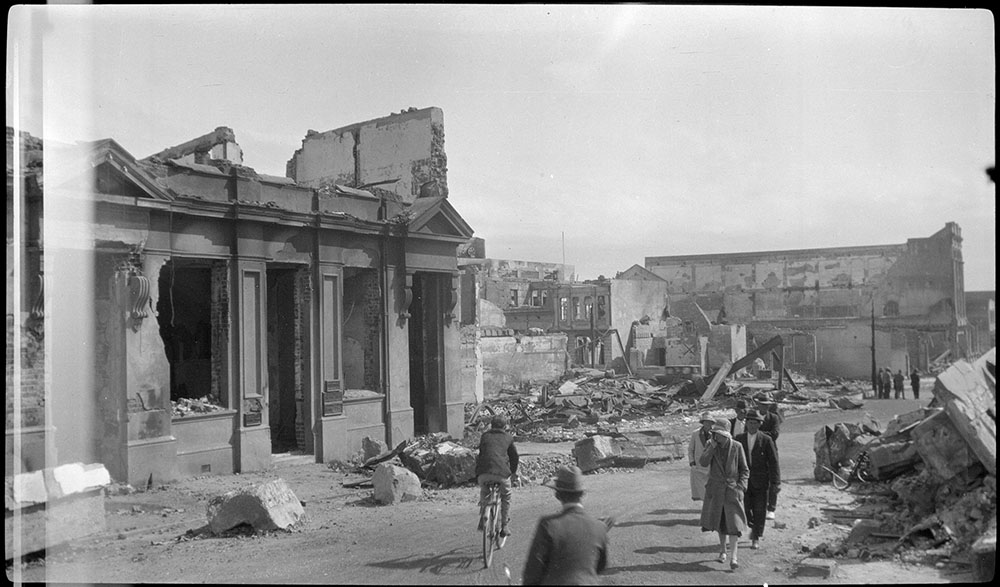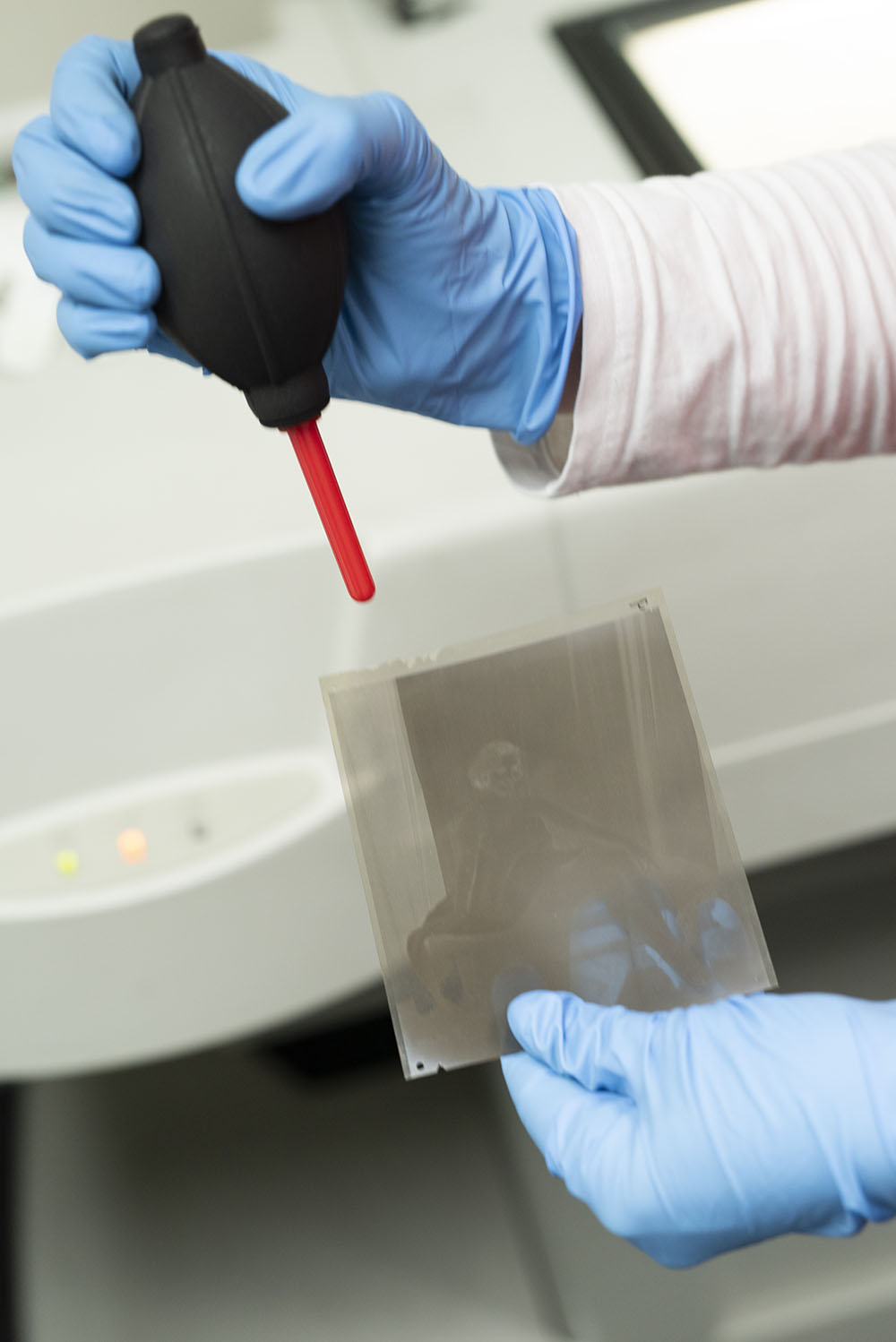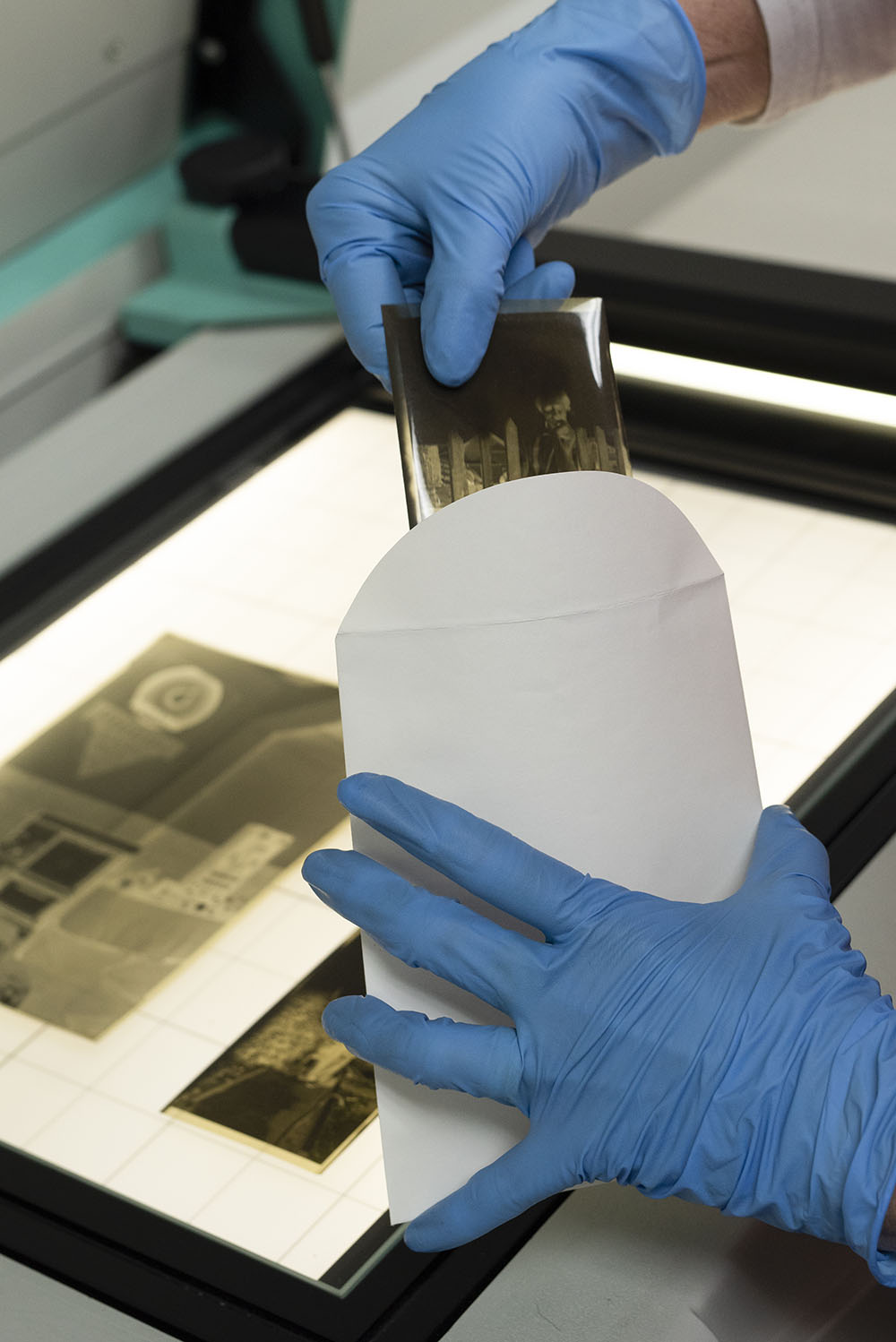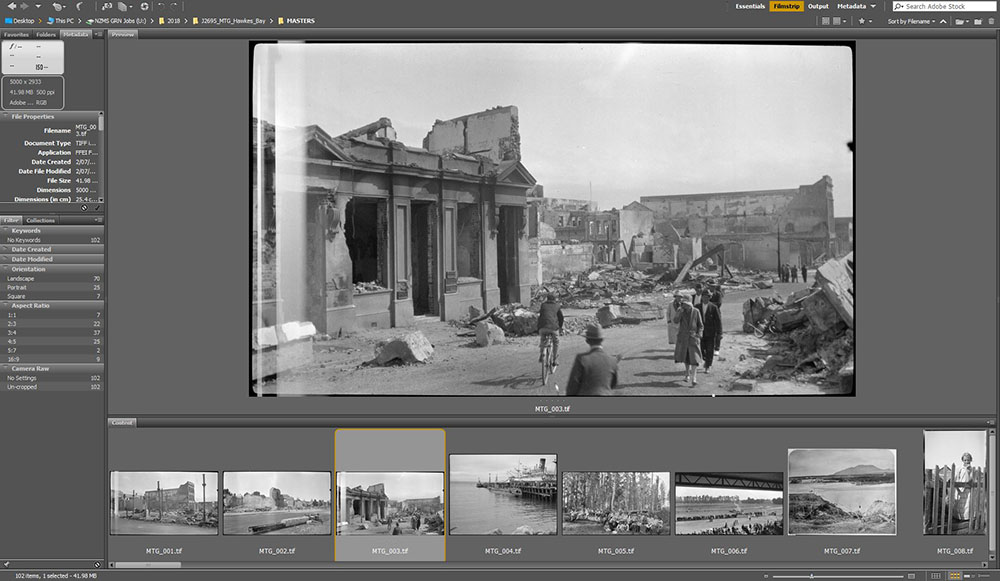Museum Theatre Gallery Hawke’s Bay (MTG) houses a vast collection and archive spanning across textiles, taonga, art, newspapers, and photographs. During MTG’s collection management hazard identification project, the Collection Coordinator, Sara Perrett, and Collection Management, Nicole Wall, discovered a series of negatives in their photographic collection that appeared to be cellulose nitrate film. This material is very hazardous, and is known to spontaneously combust, so to protect their collection they sought the advice of both NZMS and Alexander Turnbull Library (ATL).
NZMS discussed the situation with MTG, and reviewed some sample photographs of the negatives. We were able to confirm that they were indeed nitrate film and began to develop a strategy to digitise them. We recommended that MTG immediately isolate the problematic film from their other photographic material and store them in an archival box or ventilated inert container. It is especially important that the packaging is acid free because overtime acid in packaging can cause degradation to photographic material. Film should be stored in a stable, cool environment, away from heat sources and the packaging should protect items from natural light. Nitrate film poses many risks to surrounding items because it produces gases that can deteriorate the condition of any material exposed to it. These gasses can also be harmful to humans.
It was agreed that the best method to transport the dangerous negatives to our Wellington digitisation suite was for Sara and Nicole to drive them to Wellington. This eliminated any potential risks that could have arose from couriering the unstable photographic material, or the need to locate a courier who understood the importance of environmental control and handling of these items. ATL recommended that the negatives were transported on an overcast day to ensure they did not overheat. It was important that Sara and Nicole could monitor the negatives and the environment as nitrate film can self-combust at temperatures above 38 degrees Celsius.
The Collection
The MTG nitrate collection was kept in a stable and monitored environment, in separate archival envelopes and archival boxes as pictured. The collection includes a range of subjects such as some striking photographs depicting the devastation of the Napier earthquake on 3rd February 1931.

 Earthquake damage, 1931, gifted by Richard Brimer, Collection of Hawke’s Bay Museums Trust, Ruawharo Tā-ū-rangi, 8033
Earthquake damage, 1931, gifted by Richard Brimer, Collection of Hawke’s Bay Museums Trust, Ruawharo Tā-ū-rangi, 8033
The Process
Once the material was hand-delivered by Sara and Nicole, our Wellington digitisation team were able to assess the entire collection in a secure environment within our digitisation suite. The room used to assess and scan the collection was isolated from the rest of the digitisation area and could be kept at a stable temperature.


Our digitisation technician wore appropriate nitrile gloves and a mask while handling and scanning the nitrate film to protect themselves as well as the negatives. While the condition of each negative could not be determined without closer inspection, a blower brush was used to gently open the archival envelopes so that the film inside was not disturbed or damaged. The negatives were then carefully laid onto the scanner bed for digitisation and then returned to their archival housing.

Post Capture Processing (PCP) was performed to crop and adjust the levels and colour profiles of the photographs.
Signs and risks of Nitrate based film collections
The MTG nitrate negatives were in good condition; there were minimal signs of degradation – although the two images below depict discolouration that was likely caused by off-gassing. It is difficult to determine when and how damage occurs with aged photographic material because there are several steps in the photographic developing process which may have caused these problems. For example, when negatives are not processed correctly, especially when they are not agitated or fixed for long enough, this can make them more susceptible to degradation in the future. As an unstable material, that could degrade for any number of reasons, it is important to consider digitisation as a preservation method.

Left: Machine gun demonstration, World War One, gifted by Russell Orr, Collection of Hawke’s Bay Museums Trust, Ruawharo Tā-ū-rangi, [96463]. Right: New Zealand Loan and Mercantile Company, Hastings, Collection of Hawke’s Bay Museums Trust, Ruawharo Tā-ū-rangi, 7988.
Identifying Nitrate film in your collection
- Age – the first point of call for identifying nitrate film is the age (see this timeline for a guide).
- Notch Code – some but not all nitrate film has three triangular notches (acetate has two triangular notches and one “u” shaped notch) on the edge of the film. See here for visual.
- Wording – in some cases the word “nitrate” may even be on the film base.
- Smell – while degrading acetate negative smells like vinegar, a degrading nitrate negative smells sweet due to off-gassing.
- Colour – degraded nitrate can become amber in tone.
Risks
It is important to identify any nitrate (or acetate) film in your collection, and label these items as hazardous. Wear appropriate PPE relative to the condition of the items – see our Handling Resource. Nitrate film is not only at risk of self-combustion, but it can also off-gas and damage items around it (as can acetate). Therefore, it is important to isolate negatives with different chemistry or with different levels of degradation. Off-gassing only occurs when chemicals start breaking down, and negatives that are off-gassing can cause other stable negatives to also begin to break down. The more stable the environment, the better the chance of slowing degradation.
Disposal vs storage of nitrate film once digitised
Nitrate is inherently flammable, so some institutions may choose to dispose of it after digitisation rather than return it to an archival storage facility. Disposing of nitrate film needs to be carried out by an expert, in a controlled environment, because once it combusts it cannot be extinguished.
Nga Taonga and Archives NZ operate a specialised storage facility for their combined collection of nitrate film, so they would be an additional point of call if looking to relocate your nitrate as opposed to disposing of it.
MTG plan to store the collection of nitrate negatives maintaining correct storage in acid-free archival boxes and envelopes. The negatives will remain separated from other collection objects and will be inspected on a six month – yearly basis to monitor for signs of deterioration. The priority from this point will be individually catalogue the new images ready to upload to their online catalogue.

Sara Perrett, Collection Coordinator (left) and Nicole Wall, Collection Management (right) from MTG Hawkes Bay hand delivering Nitrate film collection to NZMS Wellington.
“NZMS have been incredibly understanding and their service has been exceptional. It’s not every day you unearth cellulose nitrate negatives, and with all the risks associated with the material, it is great to know this brilliant team is out there willing to take on the job. Everything was made easy for us right down to the finer details. The team even put in long hours to ensure the scans of all the negatives would be completed before we were to head back home the following day. We couldn’t be happier with the support and expertise the team at NZMS offered us.”
Do you have Nitrate in your collection?
If you’re not sure about the type of film in your collection and would like your photographs to be assessed by our team of digitisation experts, contact us today. Our resource on Acetate Film also depicts a time frame for film formats, which is a great place to start. We must emphasise that if you think there may be nitrate film in your collection, it is important to keep it isolated and at a stable temperature and humidity, as discussed in our Handling and Storage resource, until it can be safely digitised.
References:
American Museum of Natural History – Nitrate Films
Health and Safety Executive UK
http://www.hse.gov.uk/pubns/indg469.pdf
Northeast Document Conservation Centre
Library of Congress
https://www.loc.gov/preservation/care/film.html
National Film and Sound Archive of Australia
https://www.nfsa.gov.au/preservation/preservation-glossary/decomposition
